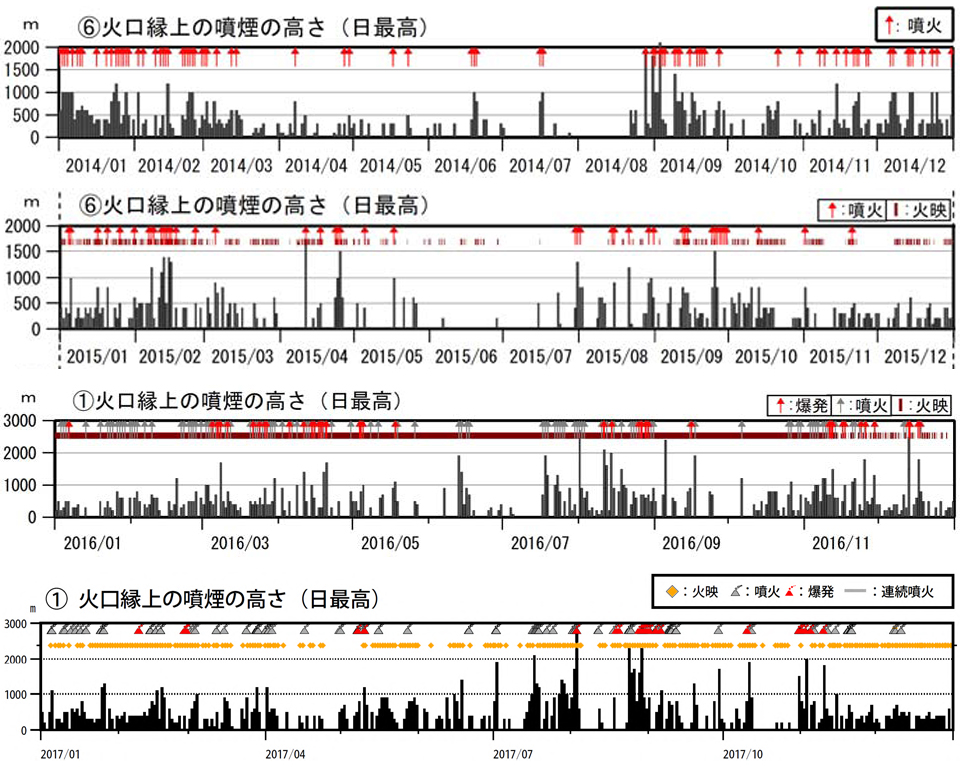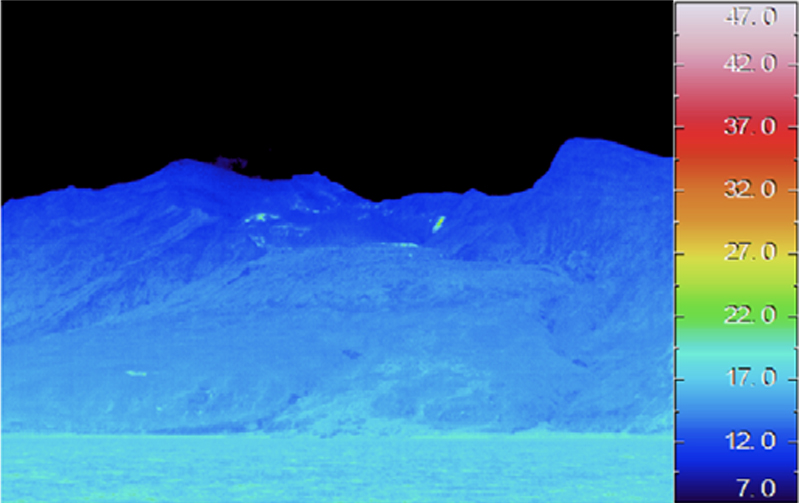Report on Suwanosejima (Japan) — March 2018
Bulletin of the Global Volcanism Network, vol. 43, no. 3 (March 2018)
Managing Editor: Edward Venzke.
Edited by A. Elizabeth Crafford.
Suwanosejima (Japan) Large explosions with ash plumes and Strombolian activity continue during 2017
Please cite this report as:
Global Volcanism Program, 2018. Report on Suwanosejima (Japan) (Crafford, A.E., and Venzke, E., eds.). Bulletin of the Global Volcanism Network, 43:3. Smithsonian Institution. https://doi.org/10.5479/si.GVP.BGVN201803-282030
Suwanosejima
Japan
29.638°N, 129.714°E; summit elev. 796 m
All times are local (unless otherwise noted)
Suwanosejima, an andesitic stratovolcano in Japan's northern Ryukyu Islands, was intermittently active for much of the 20th century, producing ash plumes, Strombolian explosions, and ash deposits. Continuous activity since October 2004 (figure 24) has consisted generally of multiple ash plumes most months rising hundreds of meters above the summit to altitudes between 1 and 3 km, and tens of reported explosions. The rate of activity began increasing during 2014; the frequency of explosions and the height of the plumes have continued to increase through 2017, which is covered in this report. Information is provided primarily by the Japan Meteorological Agency (JMA), and the Tokyo Volcanic Ash Advisory Center (VAAC).
Activity at Suwanosejima has been persistent and generally increasing during 2014-2017 (figure 25). During 2017, ash emissions rose from a few hundred to nearly 3 km above the Otake crater rim. Large explosions were reported 32 times by JMA, including 12 during August. Most explosions sent ash emissions to less than 1,000 m above the crater rim, but the highest ash plume, on 3 August 2017, rose 2.8 km above the crater rim, and was the highest recorded since observations began in 2003. Incandescence was observed at the crater from a thermal camera throughout the year and was witnessed locally many times. Many of the explosions, large and small, were heard in the nearby village. Ashfall was confirmed in the village to the SSW on nine different occasions during the year.
Activity during January-April 2017. There were no large explosions at Suwanosejima during January 2017, but occasional minor ash emissions rose as high as 1,300 m above the Otake crater rim. Incandescence was visible from the webcam on most clear nights. Ashfall was reported in the village 4 km S on 17 and 26 January. The Tokyo VAAC reported ash emissions four times in January. Ash plumes rose to 1.2 km altitude and drifted SE on 4 January; to 1.8 km and drifted W on 5 January; to 1.2 km and drifted S on 16-17 January; and to 2.1 km and drifted SE on 25 January.
In contrast with January, five large explosions were reported by JMA during February 2017. The first, on 9 February, sent an ash plume to 700 m above the crater rim. An ash emission on 18 February rose to 1,200 m above the rim (figure 26). People in the nearby village reported hearing explosions on 18, 20, 27, and 28 February. The largest explosions occurred during 27-28 February when ejecta was scattered 600 m from the crater rim. The Tokyo VAAC reported ash emissions drifting SE several times: on 9 February at 1.5 km altitude, on 16 and 17 February at 1.8 km, and during 27-28 February at 1.5 km.
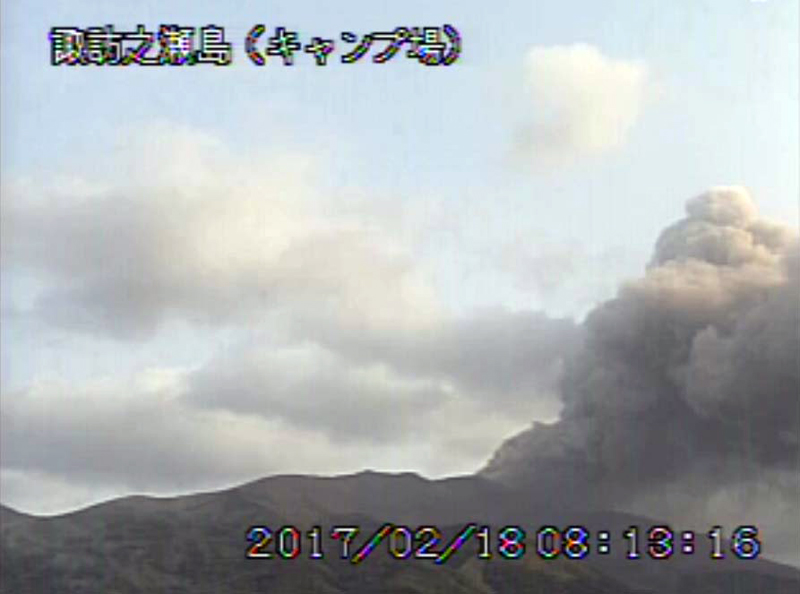 |
Figure 26. An ash emission from Suwanosejima was captured by the 'Campground' webcam on 18 February 2017. Courtesy of JMA (Suwanosejima volcanic activity report, February 2017). |
Intermittent ash emissions occurred during March 2017, but no large explosive events were reported. Ejecta was scattered around the edge of the crater on 4 March and an ash plume rose 1,000 m. Small ash plumes were noted rising 900 m on 12 and 15 March; explosions were heard in the village on 14 and 16 March, and ashfall was reported there on 25 March. Incandescence was observed at the summit intermittently throughout the month. During a field survey on 21 and 22 March, JMA noted minor thermal anomalies at the Otake Crater, the N slope of the Otake crater, and just above the coastline on the E flank (figure 27). The Tokyo VAAC reported ash emissions three times during March; on 3 March ash plumes rose to 1.5-1.8 km altitude and drifted SE and on both 28 and 31 March they rose to 1.8 km altitude and drifted SE and E.
Only minor ash emissions and occasional incandescence was reported during April 2017. Two emission events on 1 April sent ash plumes to 1,200 m above the crater rim. A tremor that lasted nine minutes occurred on 11 April and a small seismic swarm was recorded on 13 April. Small explosions were also reported on 17 and 19 April, with the 19 April event heard at the nearby village; another small explosion was reported on 30 April. There were no reports issued by the Tokyo VAAC.
Activity during May-August 2017. Activity increased slightly during May 2017; two large explosions were recorded by JMA. A small explosion was reported on 1 May, and the highest plume rose to 1,900 m above the crater rim on 10 May during a larger event. Incandescence was observed from the local village on 16 May, and explosions were heard from the village on 16 and 18 May, and again on 28 and 29 May; no ashfall was reported. The Tokyo VAAC reported ash emissions on 7, 8, and 10 May. On 7 May they reported an ash plume located 45 km S at 1 km altitude extending SW. A few hours later ash extended N at 1.5 km. An explosion on 8 May sent an ash plume to 2.1 km where it remained stationary over the volcano for much of the day before dissipating. A higher ash plume was reported on 10 May at 2.7 km altitude drifting E.
Small ash explosions occurred at Otake Crater on 8 and 21 June 2017, but there were no larger explosive events. Ash plume heights rose to only 600 m above the crater rim, and occasional nighttime incandescence was reported. No reports were issued by the Tokyo VAAC. JMA reported that the highest ash plume during July rose 2.1 km above the summit crater on 17 July, but no large explosions were recorded. Incandescence was observed intermittently throughout the month. A small explosion on 2 July sent an ash plume to 1.9 km above the crater rim. Intermittent ash emissions were noted during 17-19, 22 and 25 July. The Tokyo VAAC reported ash emissions during 2 and 16-18 July. They reported the plumes on 2 July at 1.8-2.4 km altitude, extending N for most of the day. A new explosion on 16 July sent an ash plume to 2.7 km altitude that drifted E. Intermittent ash emissions continued to drift E through 18 July at altitudes ranging from 1.8-2.1 km.
Activity increased substantially during August 2017; JMA reported 12 large explosions, nine of which occurred during the last week. Ashfall was reported in the nearby village on 2 August. The highest plume of the month was reported on 3 August, 2.8 km above the crater rim. Explosions were heard in the village on 3 and 19 August. A small explosion was reported on 12 August. Large explosions occurred on 19, 20, and 24 August in addition to the nine events during the last week. A single MODVOLC thermal alert was reported on 18 August, and the MIROVA system reported thermal anomalies during several days of the last week of the month (figure 28). The Washington VAAC reported ash on 1 August that rose to 2.4 km altitude and drifted SW. A higher plume on 3 August rose to 3.7 km and drifted W. They reported another ash plume that first rose to 3.0 km on 24 August; subsequent emissions that day were drifting NE at 2.1-2.4 km altitude. A new plume on 25 August extended E at 2.4 km. Continuing ash emissions from multiple explosions during 28-31 August rose to 1.2-3.0 km altitude and drifted SE.
Activity during September-December 2017. Four large explosions were recorded during the first week of September 2017, after which a number of smaller ash emission events were reported. Ashfall was reported four times in the nearby village on 2, 4, 29, and 30 September. The Tokyo VAAC reported explosions on 1, 4, 6, and 29 September. The ash plume from the explosion on 6 September rose to 1.5 km altitude and drifted E; on 29 September, it rose to 2.4 km altitude, also drifting E.
JMA reported four large explosions during October 2017. Two explosions occurred on 11 October; one of the ash plumes rose 1,900 m above the crater rim (figure 29). Explosions were heard in the nearby village on 12 and 31 October, and ashfall was reported on 13 October. During the large explosion of 31 October incandescent ejecta was scattered around the crater rim and the ash plume rose 1,900 m. The Tokyo VAAC reported an explosion with ash on 10 October (UTC) that rose to 2.7 km altitude and remained stationary until dissipating a few hours later. They noted that the explosion on 31 October produced a plume that rose over 1.5 km and drifted NW.
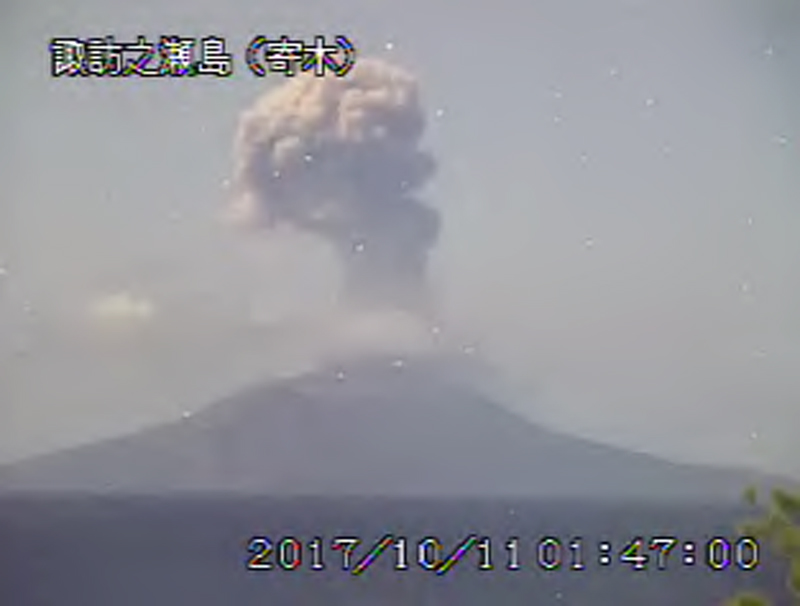 |
Figure 29. An ash plume from an explosion on 11 October 2017 rises 1.9 km above the Otake crater of Suwanosejima. Courtesy of JMA (Suwanosejima volcanic activity report, October 2017). |
JMA reported five large explosions during November 2017. Incandescent ejecta was seen around the crater rim during the explosion of 1 November, and the plume rose to 2 km above the rim. Loud explosions were heard from the nearby village on 3, 5, 6, 15, and 16 November, and ashfall was reported there on 14, 15, and 20 November. A small explosion was reported on 10 November; intermittent explosions with ash plumes rising 700 m were observed on 20 and 21 November. The Tokyo VAAC reported ash plumes at 1.5 km drifting W on 1 and 5 November, and at 1.8 km altitude drifting NW on 10 November, the last VAAC report issued for 2017.
Only small explosions were reported from Otake crater during December 2017. The highest plume rose 700 m above the crater rim. Small explosions were heard a number of times in the nearby village on 8-9, 11-13, and 26-30 December. JMA scientists visiting during 8-10 December heard intermittent explosions and witnessed incandescence visible to the naked eye. They also observed ashfall in the village on the morning of 10 December. During a field survey on 14 December, no significant changes were noted from the previous survey in March 2017 (figures 30 and 31).
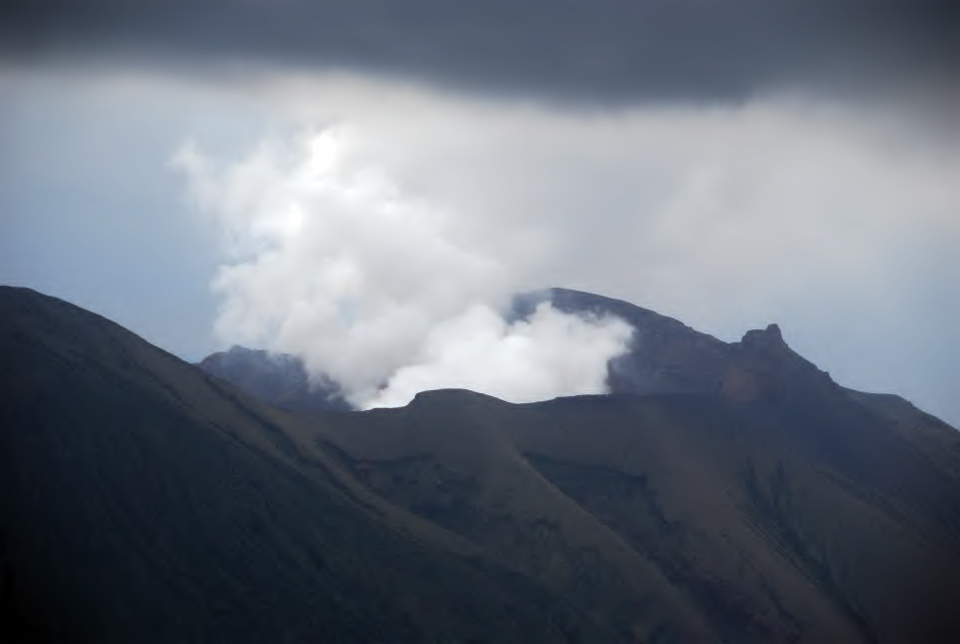 |
Figure 30. The summit of Suwanosejima with steam rising from Otake Crater taken from the W on 14 December 2017. Courtesy of JMA (Suwanosejima volcanic activity report, December 2017). |
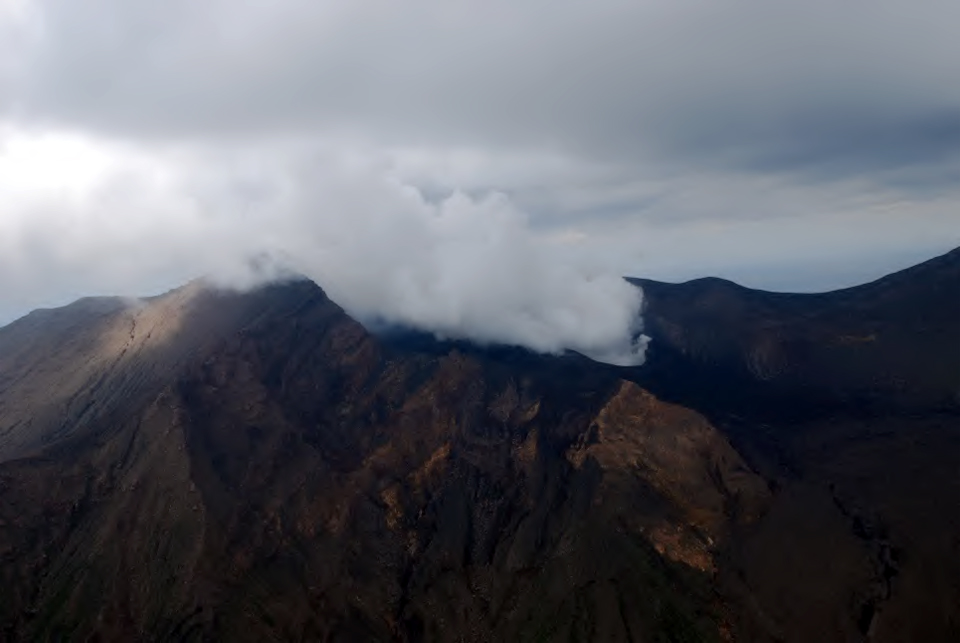 |
Figure 31. Steam rises from the Otake Crater of Suwanosejima viewed from the E on 14 December 2017. Courtesy of JMA (Suwanosejima volcanic activity report, December 2017). |
Geological Summary. The 8-km-long island of Suwanosejima in the northern Ryukyu Islands consists of an andesitic stratovolcano with two active summit craters. The summit is truncated by a large breached crater extending to the sea on the E flank that was formed by edifice collapse. One of Japan's most frequently active volcanoes, it was in a state of intermittent Strombolian activity from Otake, the NE summit crater, between 1949 and 1996, after which periods of inactivity lengthened. The largest recorded eruption took place in 1813-14, when thick scoria deposits covered residential areas, and the SW crater produced two lava flows that reached the western coast. At the end of the eruption the summit of Otake collapsed, forming a large debris avalanche and creating an open collapse scarp extending to the eastern coast. The island remained uninhabited for about 70 years after the 1813-1814 eruption. Lava flows reached the eastern coast of the island in 1884. Only about 50 people live on the island.
Information Contacts: Japan Meteorological Agency (JMA), Otemachi, 1-3-4, Chiyoda-ku Tokyo 100-8122, Japan (URL: http://www.jma.go.jp/jma/indexe.html); Tokyo Volcanic Ash Advisory Center (VAAC), 1-3-4 Otemachi, Chiyoda-ku, Tokyo, Japan (URL: http://ds.data.jma.go.jp/svd/vaac/data/); MIROVA (Middle InfraRed Observation of Volcanic Activity), a collaborative project between the Universities of Turin and Florence (Italy) supported by the Centre for Volcanic Risk of the Italian Civil Protection Department (URL: http://www.mirovaweb.it/); Hawai'i Institute of Geophysics and Planetology (HIGP) - MODVOLC Thermal Alerts System, School of Ocean and Earth Science and Technology (SOEST), Univ. of Hawai'i, 2525 Correa Road, Honolulu, HI 96822, USA (URL: http://modis.higp.hawaii.edu/).



